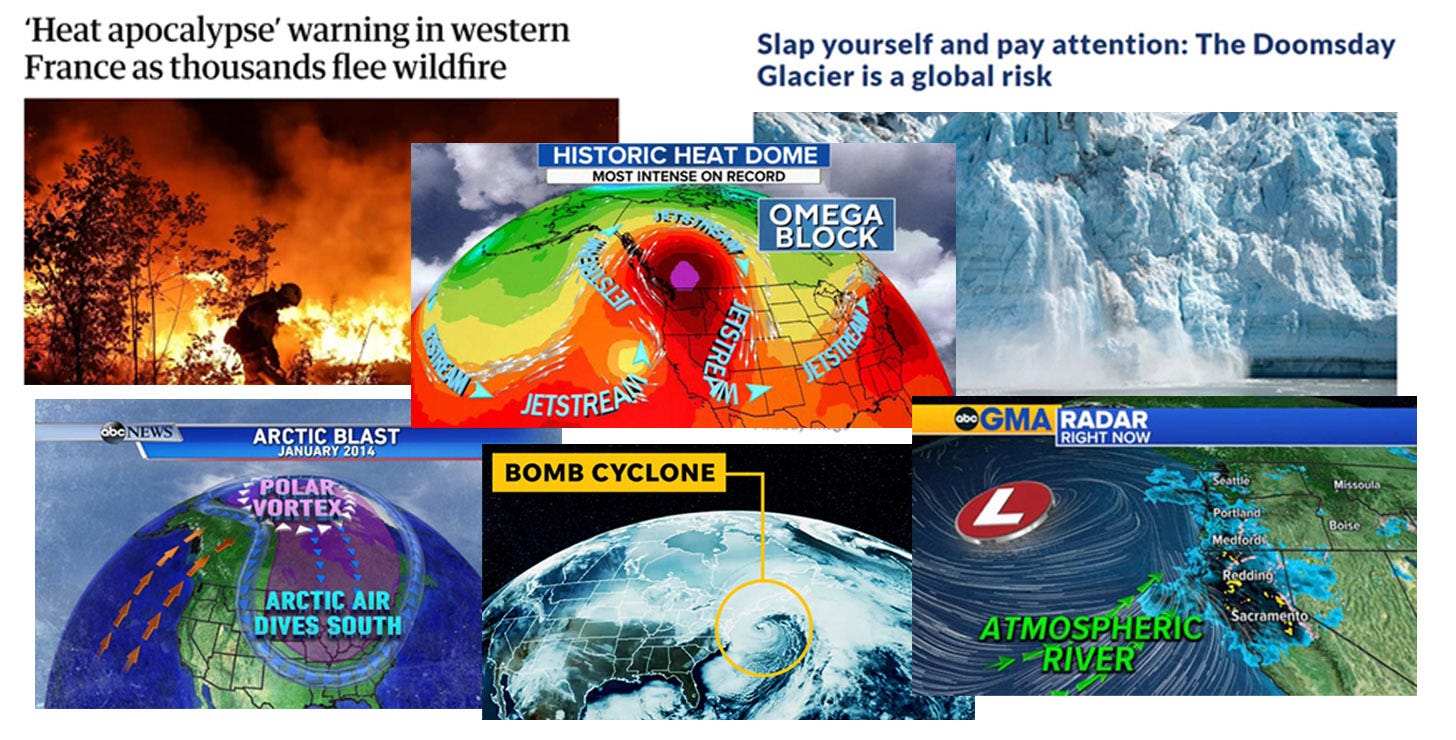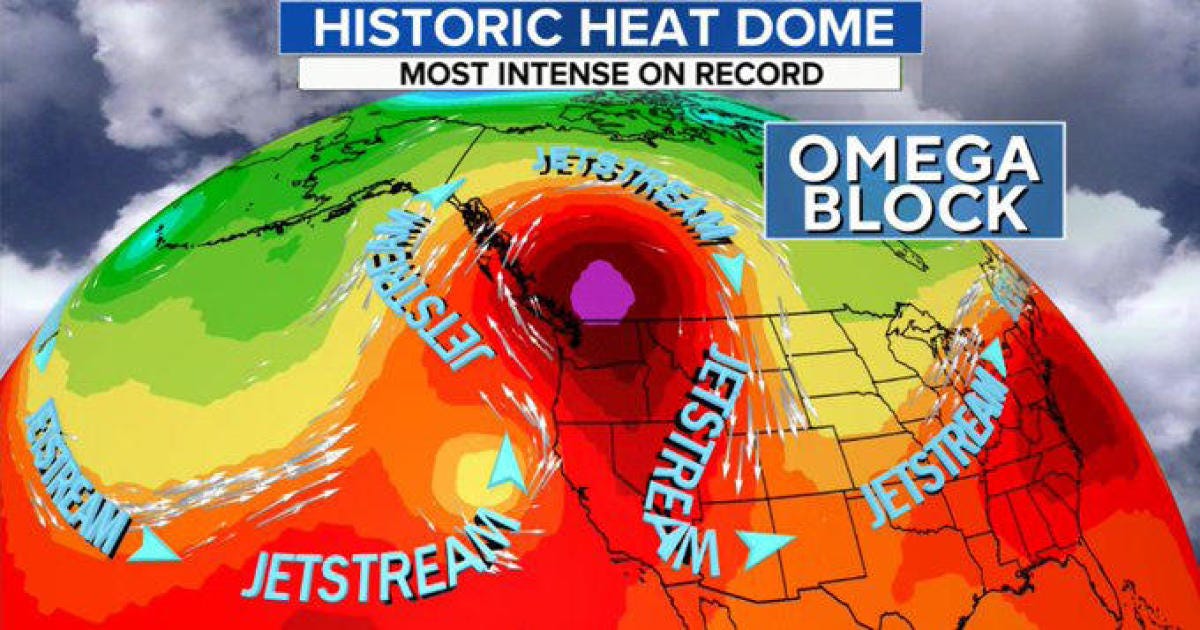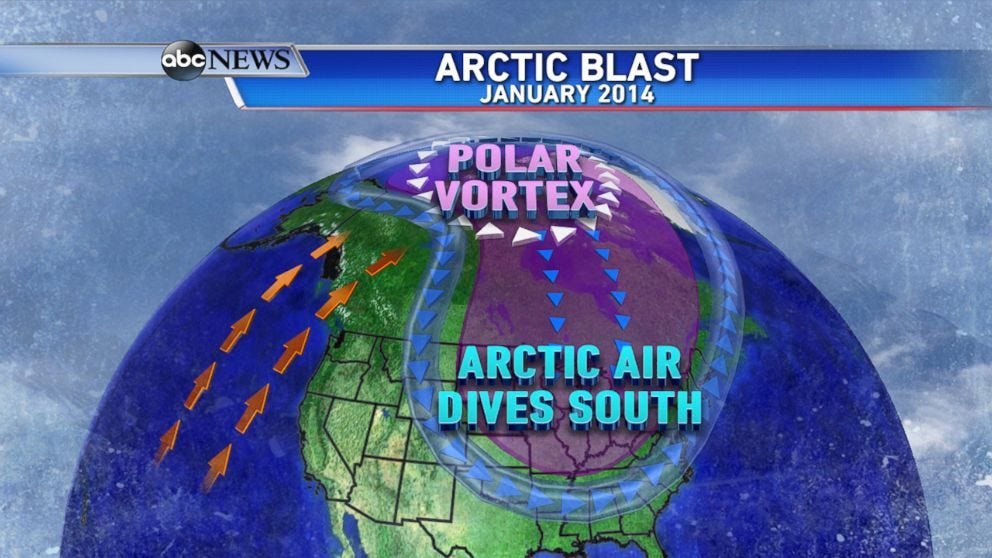What drives people to take action around an environmental cause? A good story. One that provides a plausible explanation for what people are experiencing, helps them visualize the problem being solved, and gives them a course of action that feels achievable. It worked for the ozone layer. Let's do it for global warming.
Scary.
I am one of those people who literally lays awake at night worrying about the “Doomsday Glacier” and the idea that the Gulf Stream might collapse. I know we have a lot of other stuff going on, like tyranny of the minority and the loss of our right to control our own bodies. But in my own personal anxiety management system, I prioritize “that which is unreversible” over everything else. That includes, “that which is unsurvivable.”
As I have watched the news headlines over the past few days, I can’t help but be saddled with feelings of dread and hopelessness, as the “heat apocalypse” moves across the globe and New York City is under 3 feet of water!
People must feel that there is a connection between global warming and extreme weather, even if they don’t know it for sure. Our job is to give voice to that feeling, provide a coherent narrative to explain it, and give people some direction for what to do with that feeling. This is especially true when those feelings involve fear and hopelessness.
So I offer you this road map below. I really hope that we can take this tragedy and focus it into positive action.
We broke the weather.
Don’t educate. Connect.
The public debate isn’t about conveying facts or making logical arguments. It’s about triggering – instantly and even unconsciously – people’s sense of right and wrong. But trigger words only work if they are already strongly associated in people’s brains with things those people already understand.
In the public debate, you don’t have time to teach people something new. You have to connect with the things people already know and feel.
We’ve been trying to educate people about global warming for decades. But you know what connects with people better than “2 percent over 1995 levels” or “carbon credit trading markets?”
The fact that WE BROKE THE WEATHER.
People are seeing and experiencing extreme weather. We can build a narrative around it that conveys what we believe is morally urgent about the climate challenge.
Here is the underlying message:
We royally screwed up, and large parts of this country and world will become uninhabitable sooner rather than later. As you can see, seriously bad shit is already happening but we can make things better if we get on it right now and work together to do whatever needs to be done.
The Bottom Line:
If you want to build political will behind doing something, you have to bypass the brain and go right for the heart: Trigger and connect with things that people are already feeling and experiencing, by using language that is familiar, visceral and morally unambiguous.
I am seeing lots of news about extreme weather, and lots of complaining about Joe Manchin, but very little talking directly to the public and saying, “See? This is why we need to do something serious about global warming!”
Changing the (Time) Frame
It’s a right now problem. We need a right now solution.
Quite possibly the biggest obstacle to climate action has been the perception that this problem is about the future. When faced with possibly cataclysmic events happening in the future, people tend to either put it on the back burner, go into denial, weigh more immediate concerns more heavily or all-of-the-above.
“People see climate as a tomorrow problem. We have to make them see it’s not a tomorrow problem.” - Anusha Narayanan, climate campaign director for Greenpeace USA, in The New York Times: As the Planet Cooks, Climate Stalls as a Political Issue
We have already talked about connecting with people around extreme weather: something they already understand and have strong feelings about. People may feel like there’s a connection with global warming, but in order to take that feeling and get people to act on it, you need to give people a way to make sense of what is going on.
People aren’t looking for data to make a rational decision. What people need is a good story, a rationalization they can use to motivate themselves to act in some way that alleviates their feelings of anxiety and hopelessness.
What makes a good narrative?
It doesn’t need facts or numbers. It doesn’t have to be scientifically accurate. It doesn’t have to be comprehensive. It doesn’t require caveats.
It needs to satisfy people’s emotional needs by:
Providing a plausible explanation for whatever they are experiencing or concerned about,
Giving people a way to visualize a resolution to the problem, and
Providing a course of action people can take or advocate for right now, one that makes them feel that there is at least some reasonable chance of progress.
Here’s one option. I am sure there are others.
The “Gulf Stream Collapse” Narrative
(Plausible explanation) We are experiencing extreme weather because the Jet Stream has become unstable and it’s basically swerving all over the road. The Gulf Stream is supposed to keep the Jet Stream stable, but because global warming is heating up the ocean, the Gulf Stream is slowing down and getting weaker, and it is in danger of collapsing.
(Visualize a resolution) We need to take immediate action to strengthen the Gulf Stream so it can stabilize the Jet Stream.
(Course of action) Methane does far more immediate damage than carbon dioxide. If we were to do a huge push to cut methane emissions, such as capping abandoned oil wells, we could reap short-term benefits in slowing or reducing global warming.
I offer this option, because it’s the one that made this situation make sense to me. There are lots of graphics that explain how extreme weather phenomena relate to specific malfunctions with the Jet Stream.
Plausible explanation? Check. Graphics? Check. Plausible solution? Check.
In my last issue, we talked about the “Hole in the Ozone Layer” narrative. Closing the hole in the Ozone Layer may have been the single most effective global cooperative action in human history.
If we break it down the same way, it goes like this.
(Plausible explanation) The atmosphere has an ozone layer that protects us. We made a hole in it. Now harmful radiation can get through.
(BTW - They didn’t have an immediately observable phenomenon, so we’re one-up there. But they did have lots of photos and graphics!)
(Visualize a resolution) We need to take immediate action to close the hole.
(Course of action) Something called CFCs in your aerosol cans and refrigerators made the hole. If we all stop using them, we can close the hole!
Did I mention that it wasn’t actually a hole? The narrative might not have been technically accurate, but it was incredibly effective. Why? Because it was a satisfying story.
If we could get people to come together around a big push to cap methane leaks, would it really matter if that whole “Gulf Stream Collapse” narrative was technically accurate? Not really.
If we could galvanize people to do anything that would actually make any difference, it could demonstrate that we can actually face the climate challenge and take effective, cooperative action. This would be a psychological breakthrough and potentially a tipping point in the fight to save our human habitat.
The Bottom Line:
To communicate better about our scientific issues, we need to connect them with things people already know and feel, rather than trying to teach people a lot of new science. We need to convey that those issues matter and need to be addressed right away, by telling people a story that makes sense of what is happening, gets them to visualize the solution and gives them something to do about it that doesn’t feel futile.
Our Meta-Message On Global Warming:
You see all this dangerous weather we’re having? This is why we have to do something about global warming. It was our own behavior that messed up the weather, and if we don’t do something about it asap, it’s going to get much worse.
The weather is out of control because rising water temperatures have made the Gulf Stream sluggish and weak, which makes the Jet Stream totally unstable. We have to cool the ocean, strengthen the Gulf Stream and stabilize the Jet Stream. We can do that if we move fast and work together to cut methane emissions (by doing things like capping leaky oil wells) because methane causes the bulk of the short-term damage in global warming.
Thanks, as always, for reading. I hope you are able to use this in your work and your activism!
I look forward to your feedback and ideas.
Warmest Regards,
Antonia






